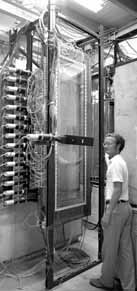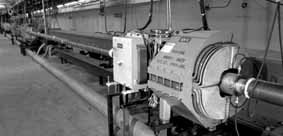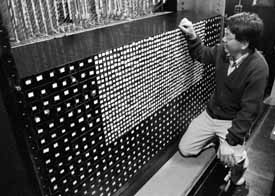 |
|
The End.. and the Beginning by Mike Perricone
"One of my fondest memories is of becoming an extraction expert," said Roger Dixon, whose Fermilab career began in the Switchyard, extracting beam from the old Main Ring and sending it to the fixed-target experimental areas, a quarter-century ago or thereabouts. About two months into his Lab career, Dixon received a 3 a.m. call at home. There was a beam problem. He jumped into his car and sped to the Lab. "When I arrived," he recalled, "I was greeted by a message on Channel 12 of the Laboratory television system that said something to the effect of`Expert Has Been Called.' I thought,`Me? Surely, they don't mean me.' Yet there it was, right on the screen, big as life. I was expected to be an extraction expert, and perform some magic." Somehow, he did. The 800 GeV fixed-target program at Fermilab drew to a close on Friday, January 21, when the beam was turned off from the Main Control Room. The shutdown marked the end of an era with antecedents in the very earliest days of the Laboratory, an era producing not only great discoveries but magical memories, and mirthful ones, too. The shutdown marked the end of an era extending back before colliding beams, and before experiment collaborations numbering in the hundreds, an era when firing particle beams at fixed targets dominated the Lab's experimental program, an era when the energy booster called the Doubler produced new phenomena in unexpected places.
"The day we went from 400 GeV to 800 GeV," recalled John Cooper, now head of the Particle Physics Division, "the cafeteria served a`Doubler.' Two hamburger patties on one bun."
A different culture
"We were a dozen guys on a mission out on the prairie, keeping our high-tech toys together with duct tape and aluminum foil," said Dan Kaplan, who worked as a graduate student on the experiment led by Leon Lederman, alongside other emerging stalwarts including Fermilab physicists Jeff Appel, Chuck Brown and Bob Kephart.
It was a different time with a different feel. "So many of us lived in it, grew up in it, had our formative experiences in that [fixed-target] program," said Joel Butler. "We saw the evolution of the field, from bubble chambers to very sophisticated high-speed electronics, silicon detectors, massive amounts of computer data. The early days were pretty crazy, and a lot of people poured a lot of their energy into that program to make it work. In some ways, there may have been a closer feeling around the Lab. I did my thesis on an experiment with 36 collaborators, and that was regarded as a huge group." Today's collider detector collaborations approach 500.
"It really isn't the end of the fixed target program at Fermilab," Shaevitz said. "We've gone through 400 GeV, then 800 GeV. Now we're dropping back to 120 GeV but with very high intensity. "Neutrino interactions will continue to be a real focus of fixed target experiments," he continued. "The energy is lower but the beam intensities will be far beyond what we used to have. With MiniBooNE here, and with MINOS sending a beam to Minnesota, this will be one of the major places--if not THE major place--for investigating neutrino oscillations at accelerators. We believe there will be a strong kaon program at the Main Injector, for CP violation studies. What makes fixed-target experiments unique is that one can have a clever idea, and think about an experiment with a smaller group. It's a complementary program to the collider program."
A history of achievement
"There are a lot of other experiments out there we could probably do," Cooper said, "but we're now in an era when you can't simply do an experiment just because you thought of it. When you first start in a new energy range, just looking is interesting. But as programs age, just looking is no longer interesting. Somebody has already done that, it takes a lot of money, and it may be deemed by the scientific community in some general way that it's not as compelling as going off to work at [the Large Hadron Collider at CERN]. Experiments must be competitive at Fermilab, and competitive in the world environment as well." There's no questioning the historical competitiveness: the fixed target program represented the energy frontier for the first half of Fermilab's existence. The major directions of particle physics research trace their origins to the fixed-target program, and Shaevitz described the linkages. The earliest experiments, he said, focused on neutral current and neutrino interactions, a key to establishing the soundness of electroweak theory, unifying the electromagnetic and weak nuclear forces. Neutral current was proposed in the electroweak theory work of Sheldon Glashow, Stephen Weinberg and Abdus Salam (they won the Nobel Prize in 1979), and Shaevitz said early neutrino fixed-target experiments at Fermilab (then the National Accelerator Laboratory) clearly demonstrated neutral current events--as did an additional observation at CERN, the European particle physics laboratory. Further precision measurements hinted that the top quark was heavy, heading experimenters down the trail that led to evidence for the top quark in 1994, and then the announcement of its discovery in 1995, during Collider Run I of the Tevatron, completed in 1996. It was a $55-million upgrade of the Tevatron that pushed the energy frontier from 400 GeV to 800 GeV in 1984, a project managed by Ken Stanfield, then head of the research division and now the Lab's deputy director. At 800 GeV, the fixed-target program remained the Lab's main experimental thrust until about 1987. With Fermilab experiments establishing its credibility, the electroweak theory pointed to the Higgs mechanism as the source of mass for the W and Z bosons. They were discovered at CERN, and finding the Higgs would be a major coup for Run II of the Tevatron. And measurements by NuTeV (Neutrinos at the Tevatron), an 800 GeV fixed target experiment for which Shaevitz was spokesman, combine with W mass measurements at CDF, DZero and CERN to point to a light Higgs particle--possibly within reach of the Tevatron when Run II opens in 2001. Discovering the upsilon particle, Shaevitz noted, has led to a "B-physics frenzy, with B-factories everywhere looking for CP violation in the B-system." The study of CP violation, the behavioral difference between matter and antimatter that might explain the very nature of the universe, took major steps just within the last two years with results from KTeV (Kaons at the Tevatron). KTeV, one of the final 800 GeV fixed-target experiments, observed both time asymmetry and direct CP violation. The list goes on. Fixed-target experiments have been instrumental in establishing quantum chromodynamics (QCD) theory, investigating how quarks behave inside protons and neutrons --also a critical factor in collider experiments. The increasing energy levels at Fermilab brought high hopes to neutrino physics, with the promise of greatly increased interaction rates. Shaevitz noted that current accelerator neutrino experiments are closely related to the work of Lederman, Jack Steinberger and Mel Schwartz at Columbia University and Brookhaven Lab in the early 1960s--for which they won the Nobel Prize in 1988. "We've just gone to higher energy," Shaevitz said. "I think their rates were a few a day, and we were getting 30 events every minute now at 800 GeV."
The future
Borrowing a phrase from another physicist, Tschirhart described the 800 GeV beam as "a proton blowtorch," the ideal tool for producing high intensities. But many in KTeV's 80-member collaboration are already preparing for a shift to the proposed KaMI (Kaons at the Main Injector) experiment, to continue their investigations into kaon decays and CP violation. If approved, KaMI and CKM (Charged Kaons at the Main Injector) would join the neutrino experiments as the core of the 120 GeV fixed target program. "We feel as if we've fully exploited the KTeV apparatus, and we're at a point of diminishing returns," Tschirhart said. "But it's a good feeling, that we built the experiment, we ran it, and we got everything we could out of it. Now we have to prepare for the next opportunity." HyperCP, the other participant in the final fixed target run, couldn't quite match KTeV's finishing kick. The experiment doubled its total data sample, but had hoped to increase it by a factor of four. HyperCP is searching for CP violation in hyperon decays (a longstanding element in the fixed target program) and in charged kaon decays, but, besides data analysis, has set no follow-up direction. "What we have to do is look over the hill and see what we'll be doing in the long term future," said experiment spokesman Craig Dukes. "What's the next experiment going to be? It's always fun to think about that next project." |
| last modified 2/11/2000 email Fermilab |
FRLsDFx9eyfrPXgV
 It was an era of great growth, sometimes instantaneous growth.
It was an era of great growth, sometimes instantaneous growth.
 It was a time when young physicists were beginning significant journeys. One such early journey produced pioneering work in hadronic production of charm particles; precision measurement of charm lifetimes; some of the first uses of the silicon vertex detectors that have since become the mainstays of present-day collider experiments; and led to the prestigious W.H.K. Panofsky Prize in particle physics in 1990 for Michael Witherell, who was named Fermilab's fourth director in March 1999.
It was a time when young physicists were beginning significant journeys. One such early journey produced pioneering work in hadronic production of charm particles; precision measurement of charm lifetimes; some of the first uses of the silicon vertex detectors that have since become the mainstays of present-day collider experiments; and led to the prestigious W.H.K. Panofsky Prize in particle physics in 1990 for Michael Witherell, who was named Fermilab's fourth director in March 1999.
 But Mike Shaevitz, a fixed-target experimenter as early as 1975 and now the Lab's Associate Director for Research, sees a change, not an end: a transition to a new direction using the Main Injector beam at 120 GeV, allowing the simultaneous operation of fixed target experiments and Tevatron collider experiments.
But Mike Shaevitz, a fixed-target experimenter as early as 1975 and now the Lab's Associate Director for Research, sees a change, not an end: a transition to a new direction using the Main Injector beam at 120 GeV, allowing the simultaneous operation of fixed target experiments and Tevatron collider experiments.

